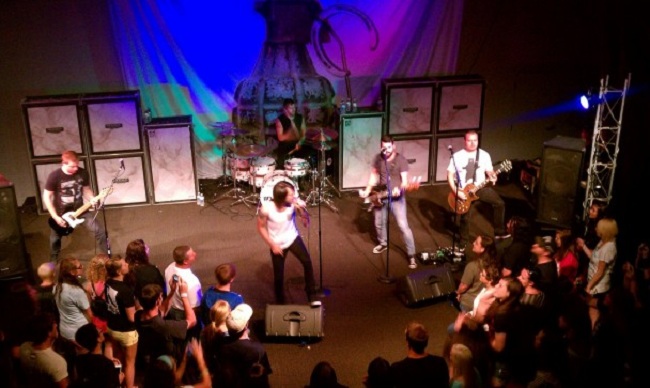PreSonus hits one out of the park with its iOS apps, QMix and SL-Remote
I’ve talked about the reasons why I bought an iPad for my job. I also talked about my first experience mixing sound from my iPad last week. That was using the app for the Yamaha M7CL that we have in our main auditorium. We recently purchased a digital console for our Family Life Center auditorium. We use that auditorium mostly for kids, youth, and also for our concerts that we host five or six times a year. Last night was the first concert we had since we installed a new PreSonus console last month.
PreSonus is a company that makes digital sound equipment and software. A good portion of the products they make have to do with recording audio. The device that we purchased for the church is the StudioLive 24.4.2. It is a 24 channel mixing digital console that comes with a lot more features than your typical analog console. If you are not familiar with the differences between an analog and a digital console, there are quite a few. As you can probably guess, a digital console basically has a computer built right into the console; this adds a lot of different options to the digital console that you can get only by purchasing a lot of extra analog equipment such as compressors, gates, de-essers, effects and so much more. I can’t get into all the differences in this post, but if you want to know more, just follow this link.
There are two apps that PreSonus makes for the iPad: QMix and SL-Remote. Both of these apps are completely free, and they each serve a completely different function for interacting with the console. The way they connect is through a computer, and the console comes with all the software you need. After installing the software and drivers on your computer, you simply hook up the console to the computer with a FireWire cable. Then, as long as your computer and iPad are on the same WiFi network, the apps should have no problem finding the console. Then you select the console in the app and hit the connect button.
 The QMix app is a lot more basic than the SL-Remote one. The whole goal of the QMix app is so your band members can mix their own monitors. Last night during sound check I told the drummer, who was using in-ear monitors, to download the app so he could mix his own monitors. The app is so easy to use that in a matter of minutes he had the app installed, connected to the console, and was setting up his monitor mix with no further instruction from me. There are two different modes you have the app in, and they are changed by either holding your phone in landscape or portrait mode. In landscape mode you are making your actual mix. You can easily turn up or down any channels you want. When you turn it into portrait mode, you get the Wheel of Me. This is a simple control wheel that, depending on what way you swipe it, will either turn you up and the rest of the band down, or it will turn the rest of the band up and you down. Mixing monitors for a band can be one of the biggest headaches of a sound check, and QMix can completely remove that headache by putting the control of their monitors in the musicians hands.
The QMix app is a lot more basic than the SL-Remote one. The whole goal of the QMix app is so your band members can mix their own monitors. Last night during sound check I told the drummer, who was using in-ear monitors, to download the app so he could mix his own monitors. The app is so easy to use that in a matter of minutes he had the app installed, connected to the console, and was setting up his monitor mix with no further instruction from me. There are two different modes you have the app in, and they are changed by either holding your phone in landscape or portrait mode. In landscape mode you are making your actual mix. You can easily turn up or down any channels you want. When you turn it into portrait mode, you get the Wheel of Me. This is a simple control wheel that, depending on what way you swipe it, will either turn you up and the rest of the band down, or it will turn the rest of the band up and you down. Mixing monitors for a band can be one of the biggest headaches of a sound check, and QMix can completely remove that headache by putting the control of their monitors in the musicians hands.
 The other app you can use is called SL-Remote. This app is made to have full control over the sound board. You can do almost everything using this app as you could by using the actual console. There is also at least one function that I found that you can tweak on the app that I have yet to find a way to do on the console itself. Last night when the final band came up to play, I handed my iPad to their sound man. He happily took it, tweaked a few things on the console, then walked downstairs so he could hear what it sounded like in front of the stage where the 200 people who came to see the band were. That way he could hear exactly what the paying customers were hearing. This ensured a great concert experience for everyone, the way it should be.
The other app you can use is called SL-Remote. This app is made to have full control over the sound board. You can do almost everything using this app as you could by using the actual console. There is also at least one function that I found that you can tweak on the app that I have yet to find a way to do on the console itself. Last night when the final band came up to play, I handed my iPad to their sound man. He happily took it, tweaked a few things on the console, then walked downstairs so he could hear what it sounded like in front of the stage where the 200 people who came to see the band were. That way he could hear exactly what the paying customers were hearing. This ensured a great concert experience for everyone, the way it should be.
All in all, I can honestly say I don’t think the concert last night would have been as big of a hit without the ability to grab the iPad and mix from the floor. At one point I even grabbed the iPad and headed to the backstage area. I had to tell the bass player to turn down his amp, and I didn’t have to worry about leaving the console unattended in case something happened (and let me tell you, anything can happen during a concert). When the next band got up, in the middle of one of their songs the lead singer was jumping about on stage and knocked his vocal mic over. It went right in front of the speakers, and if you weren’t aware, a hot mic in front speakers means instant ear piercing noise. I now don’t have to worry about walking away from the console again, as long as I have my iPad in hand.



